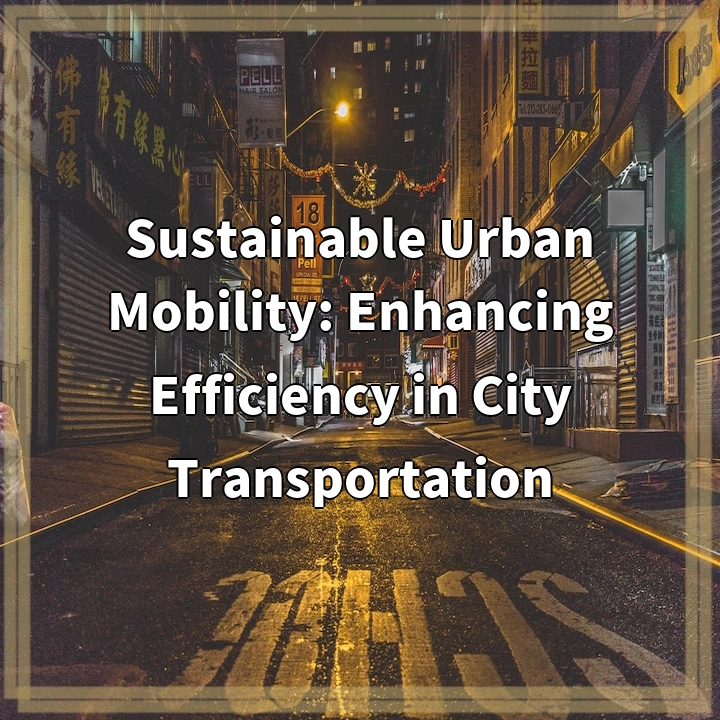
What is Sustainable Urban Mobility?
Sustainable Urban Mobility refers to the concept of achieving efficient and environmentally-friendly transportation systems in urban areas. It focuses on integrating various modes of transportation, such as public transit, cycling, walking, and carpooling, in a way that reduces congestion, emissions, and overall reliance on single-occupancy vehicles. The goal is to create a mobility ecosystem that is sustainable, accessible, and equitable for all residents.
Real-World Problems Associated with Sustainable Urban Mobility
1. Congestion
One of the major challenges in achieving sustainable urban mobility is dealing with high levels of traffic congestion. As cities grow and populations increase, roads become more congested, leading to delays, increased fuel consumption, and higher emissions. Finding effective solutions to manage and reduce congestion is crucial for improving the efficiency of urban transportation systems.
2. Limited Accessibility
Accessibility is another important issue in sustainable urban mobility. Many urban areas lack adequate public transportation infrastructure, making it difficult for residents to access essential services, including schools, workplaces, healthcare facilities, and recreational areas. This issue is particularly prominent in low-income communities where transportation options are limited, resulting in mobility and socioeconomic inequalities.
3. Environmental Impacts
Traditional modes of transportation, such as private cars, contribute significantly to air pollution and greenhouse gas emissions. This poses environmental challenges and negatively impacts public health. Achieving sustainable urban mobility involves transitioning to cleaner and greener modes of transportation, such as electric vehicles, and promoting the use of non-motorized transportation options like cycling and walking.
4. Land Use and Infrastructure
The design and layout of urban areas play a crucial role in sustainable urban mobility. Poor urban planning, inefficient land use, and inadequate infrastructure can hinder the development of effective transportation networks. Creating compact and connected communities, implementing smart growth strategies, and investing in sustainable infrastructure are key considerations in addressing these challenges.

Solutions for Sustainable Urban Mobility
1. Integrated and Efficient Public Transportation
Investing in a reliable and well-connected public transportation system is crucial for promoting sustainable urban mobility. This includes expanding public transit networks, improving frequency and coverage, and integrating different modes of transportation. Implementing smart technologies and efficient scheduling systems can enhance the reliability and convenience of public transportation options.
2. Active Transportation and Non-Motorized Modes
Encouraging active transportation modes like walking and cycling can significantly reduce congestion and emissions. Creating safe and accessible pedestrian and cycling infrastructure, such as bike lanes and sidewalks, can help promote these modes of transportation. Implementing bike-sharing programs, pedestrian-friendly streets, and promoting the concept of “complete streets” can facilitate active transportation in urban areas.
3. Carpooling and Ride-Sharing Initiatives
Promoting carpooling and ride-sharing initiatives can help reduce the number of single-occupancy vehicles on the road. Encouraging the use of carpooling apps, providing dedicated carpool lanes, and offering incentives for ride-sharing can incentivize commuters to share their rides, leading to less congestion and decreased emissions.
4. Sustainable Infrastructure Development
Investing in sustainable infrastructure is crucial for achieving sustainable urban mobility. This involves building and improving public transit facilities, creating efficient intermodal connections, and integrating transport hubs with other urban amenities. Additionally, implementing smart city technologies and using data-driven solutions can optimize traffic management and improve overall transportation efficiency.
5. Urban Planning and Land Use Strategies
Incorporating sustainable urban planning principles is essential for promoting efficient transportation systems. Prioritizing mixed-use developments, creating compact and walkable communities, and designing neighborhoods around transit hubs can reduce the reliance on private vehicles. By integrating transportation planning with land use decisions, we can foster more sustainable and livable cities.















